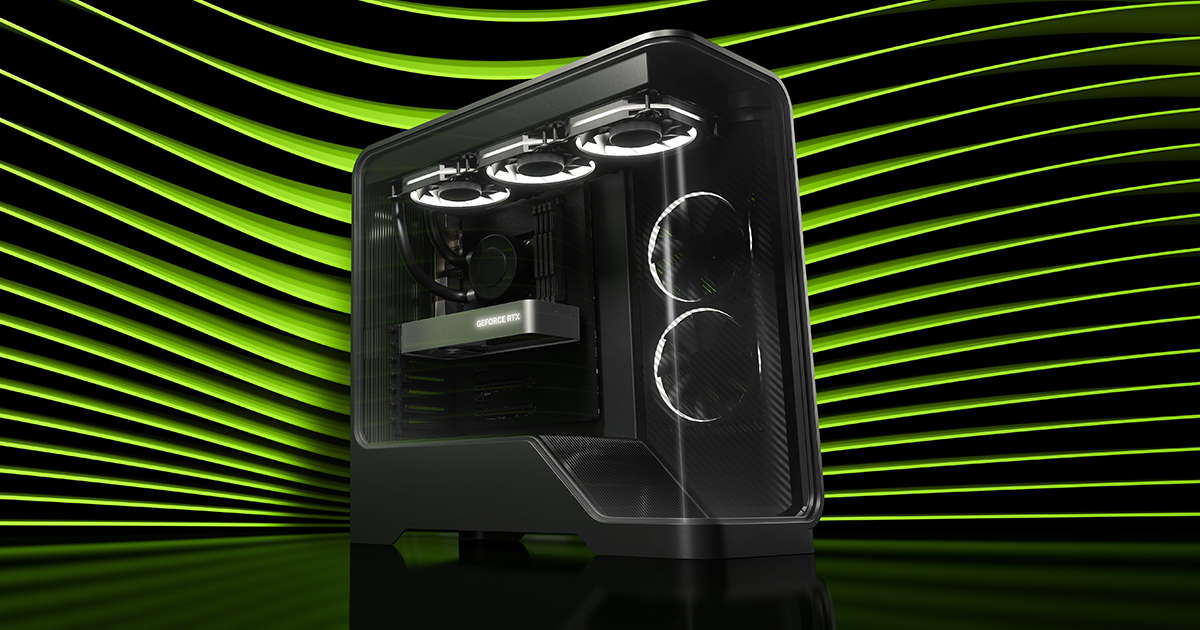The NVIDIA GeForce RTX 5070 Ti graphics cards — built on the NVIDIA Blackwell architecture — are out now, ready to power generative AI content creation and accelerate creative performance.
GeForce RTX 5070 Ti GPUs feature fifth-generation Tensor Cores with support for FP4, doubling performance and reducing VRAM requirements to run generative AI models.
In addition, the GPU comes equipped with two ninth-generation encoders and a sixth-generation decoder that add support for the 4:2:2 pro-grade color format and increase encoding quality for HEVC and AV1. This combo accelerates video editing workflows, reducing export times by 8x compared with single encoder GPUs without 4:2:2 support like the GeForce RTX 3090.
The GeForce RTX 5070 Ti GPU also includes 16GB of fast GDDR7 memory and 896 GB/sec of total memory bandwidth — a 78% increase over the GeForce RTX 4070 Ti GPU.

NVIDIA DLSS 4, a suite of neural rendering technologies that uses AI to boost frames per second (fps) and improve image quality, is now available in professional-grade 3D apps like Chaos Vantage. D5 Render also adds DLSS 4 in beta with the new Multi Frame Generation feature to boost frame rates by 3x. 3D rendering software Maxon Redshift also added NVIDIA Blackwell support, providing a 30% performance increase.
The February NVIDIA Studio Driver, with support for the GeForce RTX 5070 Ti GPU, will be ready for download next week. For automatic Studio Driver notifications, download the NVIDIA app.
Use NVIDIA’s product finder to pick up a GeForce RTX 5070 Ti GPU or prebuilt system today. Check back regularly after 6 a.m. PT, as retail partners list their available models. Explore complete specifications.
Ready for the Generative AI Era
Black Forest Lab’s FP4-optimized FLUX.1 [dev] suite of image generation models is now available on Hugging Face.
FP4 is a lower quantization method, similar to file compression, that decreases model sizes. FLUX.1 [dev] at FP4 requires less than 10GB of VRAM, compared with over 23GB at FP16.
This means the state-of-the-art FLUX.1 [dev] model can run on the GeForce RTX 5070 Ti GPU as well as all GeForce RTX 50 Series GPUs. This is important because the FLUX.1 [dev] model wouldn’t be able to run at FP16, given memory constraints.
On the GeForce RTX 5070 Ti GPU, the FLUX.1 [dev] model can generate images in just over eight seconds on FP4, compared with 20 seconds on FP8 on a GeForce RTX 4070 Ti GPU.
Versatile Viewports
DLSS 4 is now available in Chaos Vantage and D5 Render in beta — popular professional-grade 3D apps for architects, animators and designers.
Both apps natively support DLSS 4’s improved Super Resolution and Ray Reconstruction models — powered by transformers — to increase image detail and improve stability.
D5 Render also supports DLSS 4’s DLSS Multi Frame Generation to boost frame rates by using AI to generate up to three frames per traditionally rendered frame.
This enables animators to smoothly navigate a scene with multiplied frame rates and render 3D content, even with massive file sizes, at 60 fps or more.
Maxon Redshift — a 3D rendering software that uses GPU acceleration to visualize 3D models, scenes, animations and designs — has released an update to fully harness GeForce RTX 50 Series GPUs, accelerating performance by up to 30%.
Every month brings new creative app updates and optimizations powered by the NVIDIA Studio platform. Follow NVIDIA Studio on Instagram, X and Facebook. Access tutorials on the Studio YouTube channel and get updates directly in your inbox by subscribing to the Studio newsletter.
See notice regarding software product information.